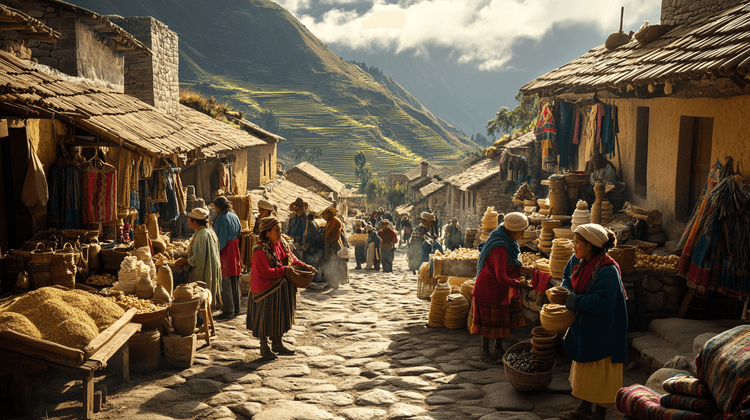Daily Life of Inca and Maya Civilizations - Culture & Society

Both the Inca and Maya had well-organized, complex societies with distinct roles for various classes of society. In the Inca Empire, society was rigidly hierarchical. There was the Sapa Inca, or "favorite son" of the Sun God, at the top, followed by nobles, priests, artisans, farmers, and laborers. Families resided in ayllus - community households that owned land and worked together. Men labored in public works, whereas women were engaged mostly in weaving and cooking. Children were educated by word of mouth and by telling stories, an important aspect of maintaining their culture.
The Maya civilization, on the other hand, was a collection of independent city-states, each ruled by its own ruler. Though they had kings and nobles, power was decentralized. The nobles were tasked with religious rituals, while common folk farmed, made goods, and fought in the army when called upon. Education was only available for the priesthood and nobles, who learned to read and studied astronomy, mathematics, and calendrical systems.
Inventions and Scientific Advances
Both cultures contributed significantly to human science. The Incas were farming pioneers. They developed terraced agricultural systems in order to plant crops on steep land, which not only avoided soil loss but also guaranteed food availability. They established freeze-drying methods (utilized to preserve potatoes, referred to as chuño), sophisticated irrigation systems, and suspension bridges constructed with braided grass.
Another of the most intriguing things about visiting Inca and Maya civilizations is their early achievement of engineering feats without iron tools or wheels. The fact that they could build extensive road networks, temples, and observatories is nothing short of astounding.
The Maya people were masters in mathematics, astronomy, and writing. They developed the idea of zero centuries ahead of Europeans. Their calendar system, Long Count, could calculate time over millennia, and they were able to predict celestial phenomena like eclipses. They constructed observatories such as El Caracol, with windows designed to observe Venus and other celestial bodies.
Their hieroglyphic writing system, which was made up of more than 800 symbols, documented all from royal heritage to mythical stories. It is therefore an amazing adventure for any child or grown-up who wants to know how knowledge changed over the centuries.
Trade, Economy, and Resource
Both civilizations depended on trade, although they practiced it in a different manner. The Incas employed a centrally planned economy. Instead of currency, they existed on a barter economy and dispensed products through warehouses called qollqas. Roads linked remote areas of the empire to facilitate food and material transport. The Chasquis (messengers) transported goods and messages, with evidence of a highly developed communication and logistics system.
The Maya, however, possessed a more decentralized economy. Cities were linked by land and water with trade routes. The main goods traded were jade, obsidian, cacao, salt, clothing, and feathers. Markets were gathering places, and artisans would sell their artwork for food products. These systems of trade permitted both empires to prosper and culturally assimilate.
Religion, Mythology, and Art
When delving into Inca and Maya cultures, their mythologies provide some of the most fascinating stories. The Incas revered the Sun God Inti, the Moon Goddess Mama Killa, and the god of creation Viracocha. Temples were constructed with gold-embellished walls, and celebrations were used to honor the gods with music, dance, and feasting. Their artwork frequently consisted of deities, animals, and celestial objects, illustrating the overlap between everyday life and divine thought.
The Maya possessed a large pantheon of deities who were related to natural forces, agriculture, and celestial phenomena. Human sacrifice occurred in some ceremonies, particularly when drought or war was prevalent. Their myths, such as the Popol Vuh, relating the Hero Twins and their passage through the underworld, give rich insight into their religious world. Art and sculpture were usually stone-carved and painted in bright colors on pottery and walls.
These books are more than stories - they are precious cultural blueprints. Allow your child to immerse themselves in mythology and learn to construct their worlds through writing.
Gender Roles and Family Structures
In both societies, gender roles were well-defined. In Inca society, women had a significant role to play in religious rituals and weaving. Girls were usually trained early in weaving and food preparation, and some were selected to be "Chosen Women" (Acllas) who were priests of the Sun God in temples. Men had to farm, join the military, or engage in public service.
The Maya were patriarchal too, but noble women did have some levels of power, particularly in the court and religion. The family was very intimate, and homes hosted extended family members. Marriages were frequently arranged to preserve alliances between noble families. These long-standing traditions provide rich fodder for children who are interested in old tales and cultural evolution.

Inventions and Scientific Contributions
Both civilizations made outstanding contributions to human knowledge. The Incas were agricultural innovators. They created terraced farming systems to grow crops on mountainous terrain, which not only prevented soil erosion but also ensured food supply. They developed freeze-drying techniques (used for storing potatoes, called chuño), advanced irrigation systems, and suspension bridges made of woven grass.
One of the most fascinating aspects of exploring Inca and Maya civilizations is recognizing their early mastery of engineering without the use of iron tools or wheels. Their ability to construct vast road networks, temples, and observatories is awe-inspiring.
The Maya civilization excelled in mathematics, astronomy, and writing. They were among the first to develop the concept of zero, centuries before Europeans. Their Long Count calendar could track time over thousands of years, and they accurately predicted celestial events such as eclipses. They built observatories like El Caracol, which had windows aligned to track Venus and other heavenly bodies.
Their hieroglyphic writing system, composed of over 800 symbols, recorded everything from royal lineage to mythological tales. This makes the journey of the Inca and Maya civilizations an incredible one for any child or adult interested in how knowledge evolved across the ages.
Trade, Economy, and Resource
Trade was crucial to both civilizations, though they approached it differently. The Incas used a centrally controlled economy. Rather than using currency, they operated on a barter system and distributed goods via storehouses known as qollqas. Roads connected distant parts of the empire to ensure food and material movement. The Chasquis (runners) carried messages and goods, showcasing an efficient communication and logistics network.
The Maya, on the other hand, had a more decentralized economy. Trade routes connected cities through land and waterways. Key trade goods included jade, obsidian, cacao, salt, textiles, and feathers. Markets were social hubs, and artisans would exchange their crafts for agricultural products. These trade systems allowed both empires to flourish and integrate culturally.
Religion, Mythology, and Art
When exploring Inca and Maya civilizations, their rich mythologies offer some of the most engaging narratives. The Incas worshipped the Sun God Inti, the Moon Goddess Mama Killa, and the creator god Viracocha. Temples were built with gold-plated walls, and festivals were celebrated with music, dance, and feasting. Their art often depicted deities, animals, and celestial symbols, reflecting the connection between daily life and divine beliefs.
The Maya had a vast pantheon of gods associated with natural elements, agriculture, and celestial bodies. Human sacrifice was practiced during certain rituals, especially in times of drought or war. Their stories, like the Popol Vuh, which tells of the Hero Twins and their journey through the underworld, provide deep insight into their spiritual world. Art and sculpture were often carved in stone and painted in vivid colors on ceramics and walls.
These stories are not just tales - they are valuable cultural blueprints. Let your child dive into mythology and learn to build their worlds through writing.

Conclusion
Exploring the Inca and Maya civilizations is not just an academic pursuit - it's a journey into two of the most remarkable cultures in human history. Their achievements in architecture, agriculture, astronomy, and governance continue to amaze historians, archaeologists, and educators alike. The Incas demonstrated the power of unity and infrastructure in building a vast, organized empire across challenging terrain. Meanwhile, the Maya excelled in intellectual and artistic pursuits, leaving behind a legacy of knowledge that still shapes our understanding of ancient science and spirituality.
What makes these civilizations even more compelling is how much they valued storytelling, myth, and cultural preservation - values that resonate deeply with today’s world. Whether it’s the intricate knots of the Inca quipu or the poetic symbolism of Maya hieroglyphs, their methods of communication tell stories that deserve to be heard by every generation.
By understanding the lives, beliefs, and innovations of these ancient peoples, we enrich our own. Encouraging children to study and write about such civilizations not only fosters curiosity but also builds essential creative thinking skills.
FAQs
Q1. What is the difference between the Inca and Maya civilizations?
Ans: The Incas were based in the Andes Mountains of South America, had a centralized government, and used a road network for control. The Maya lived in Mesoamerica, operated as independent city-states, and were highly advanced in astronomy and writing.
Q2. Why are the Maya and Inca civilizations important to study?
Ans: They made significant contributions to agriculture, architecture, mathematics, and culture. Studying them helps us understand early human innovation and societal organization.
Q3. Did the Maya and Inca civilizations exist at the same time?
Ans: There was some overlap. The Maya civilization began earlier (around 2000 BCE) and declined gradually, while the Inca Empire rose to prominence in the 1400s and fell in the 1500s.
Q4. How do the modern descendants of the Maya live today?
Ans: Millions of Maya descendants live in Central America today. They continue to speak Mayan languages, follow traditional customs, and preserve their cultural identity.
Personalized Communication Report
Record a video to get a AI generated personalized communication report for your child

Hi There, want to try these
tips for your child with
LIVE with our expert coach?
Let's check your child's
English fluency
